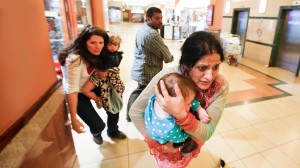Movie a Day Blog admires HBO for continuing to churn out one fascinating documentary after another under the stewardship of Sheila Nevins.
Rarely does an HBO Documentary Films production disappoint, and the latest compelling example is TERROR AT THE MALL (2014), a riveting account of the violent takeover one year ago of an upscale shopping mall in Kenya by Somalian members of Al-Shebaab, an Al Queda-linked terrorist group.
Using almost exclusively the CCTV security cameras operating throughout the two level mall, British documentary filmmaker Dan Reed, who also directed TERROR IN MUMBAI (2009) for HBO, stitches together a fully dramatic narrative in TERROR AT THE MALL. Having the benefit of hindsight, of course, and knowing how matters will turn out (71 dead and hundreds wounded), Reed is able to build first a sense of calm commerce in the mall, and then the sudden and immediately violent attack.
Using footage from more than 100 closed-circuit cameras operating in the mall, Reed shows us the silent infiltration of the mall roof by a small band of only four heavily-armed terrorists. They spread like snakes through the mall and then start firing at anyone who moves: women, children and men, all scurrying for cover and most of them failing to find it.
Reed focuses on a few key characters, including a group of women and children who hid behind a flimsy sales display in the mall walkway, and almost made it out unscathed, and others whose hiding places proved insufficient. The strangest testimony from the survivors, all filmed in typical documentary interview style nondescript backgrounds well after the events depicted, concerned the repeated apologies and remorse from the assassins, who said they were only retaliating against Western forces who murdered their families in nearby Somalia.
The victims were both astonished and mortified: they had just witnessed these terrorists mowing down women and children, but now they were letting their captives flee to safety and apologizing all the while. The most shocking aspect of TERROR AT THE MALL is not what the terrorists did inside, which was exactly as expected, but what the police and security forces failed to do outside.
Despite assembling almost immediately after the invasion was reported by fleeing customers, the police proceeded to argue and dither and do nothing, while numerous victims perished inside due to blood loss and lack of medical support. Mall shoppers cowered behind meat counters and under tables for four hours waiting for the police to finally appear, and one man, in a heart-rending account, watched his wife die before his eyes because there was no way to stop her bleeding from gunshot wounds.
It was only a small group of off-duty police and detectives who finally had the nerve to enter the mall and engage in a fierce shoot-out with the terrorists. Some of the cops died, and the police retreated, finally relying on fire bombing the mall to declare victory by burning the terrorists alive in their original target.
By relying so heavily on the dispassionate and silent security footage, Reed communicates a sense of grim inevitability to the proceedings, and even though we may remember the outcome from news reports, I found myself fully engaged in the drama of the moment.
The film has also been cited as proof of how black and white people can help each other, as so many did in this crisis without an apparent thought to race or class. They shared the horrible distinction of being terrorist victims together, a designation they would never seek but will haunt the survivors forever.
We live in an era where episodes such as the one depicted in TERROR AT THE MALL will become more commonplace, and touch more and more lives in an ever-expanding circle of action and consequences. But facing our dilemma in such stark, black-and-white terms can only stiffen our resolve not to be the next set of victims.



Comments are closed